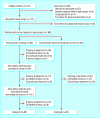Using an electrocautery strategy or recombinant follicle stimulating hormone to induce ovulation in polycystic ovary syndrome: randomised controlled trial
- PMID: 14739186
- PMCID: PMC318481
- DOI: 10.1136/bmj.328.7433.192
Using an electrocautery strategy or recombinant follicle stimulating hormone to induce ovulation in polycystic ovary syndrome: randomised controlled trial
Abstract
Objective: To compare the effectiveness of an electrocautery strategy with ovulation induction using recombinant follicle stimulating hormone in patients with polycystic ovary syndrome.
Design: Randomised controlled trial.
Setting: Secondary and tertiary hospitals in the Netherlands.
Participants: 168 patients with clomiphene citrate resistant polycystic ovary syndrome: 83 were allocated electrocautery and 85 were allocated recombinant follicle stimulating hormone.
Intervention: Laparoscopic electrocautery of the ovaries followed by clomiphene citrate and recombinant follicle stimulating hormone if anovulation persisted, or induction of ovulation with recombinant follicle stimulating hormone.
Main outcome measure: Ongoing pregnancy within 12 months.
Results: . The cumulative rate of ongoing pregnancy after recombinant follicle stimulating hormone was 67%. With only electrocautery it was 34%, which increased to 49% after clomiphene citrate was given. Subsequent recombinant follicle stimulating hormone increased the rate to 67% at 12 months (rate ratio 1.01, 95% confidence interval 0.81 to 1.24). No complications occurred from electrocautery with or without clomiphene citrate. Patients allocated to electrocautery had a significantly lower risk of multiple pregnancy (0.11, 0.01 to 0.86).
Conclusion: The ongoing pregnancy rate from ovulation induction with laparoscopic electrocautery followed by clomiphene citrate and recombinant follicle stimulating hormone if anovulation persisted, or recombinant follicle stimulating hormone, seems equivalent to ovulation induction with recombinant follicle stimulating hormone, but the former procedure carries a lower risk of multiple pregnancy.
Figures
References
-
- Franks S. Polycystic ovary syndrome. N Engl J Med 1995;333: 853-61. - PubMed
-
- Balen A, Michelmore K. What is polycystic ovary syndrome? Hum Reprod 2002;17: 2219-27. - PubMed
-
- Homburg R. What is polycystic ovarian syndrome? Hum Reprod 2002;17: 2495-9. - PubMed
-
- Imani B, Eijkemans MJ, te Velde ER, Habbema JD, Fauser BC. Predictors of patients remaining anovulatory during clomiphene citrate induction of ovulation in normogonadotropic oligoamenorrheic infertility. J Clin Endocrinol Metab 1998;83: 2361-5. - PubMed
-
- Jacobs HS, Agrawal R. Complications of ovarian stimulation. Baillierès Clin Obstet Gynaecol 1998;12: 565-79. - PubMed
Publication types
MeSH terms
Substances
LinkOut - more resources
Full Text Sources
Other Literature Sources
Medical


